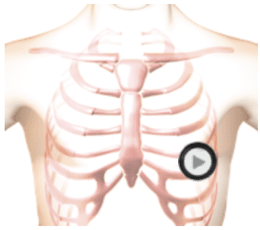S1 Heart Sounds Introduction.
Introduction
Learn about the S1 heart sound, listen to examples, take short lessons and compare to other heart sounds. For all medical professionals.
Our S1 heart sound lessons can be found in this first heart sounds module. In addition, our reference index is designed to provide quick access to first heart sounds, with audio tracks, listening guides and waveforms. Use this link for quick reference to heart and lung sounds.
What is an S1 Heart Sound?
S1 heart sound is a low frequency sound, occurring at the beginning of systole. S1 can be best heard over the apex, using a stethoscope's bell or diaphragm. The first heart sound is caused by turbulence created when the mitral and tricuspid values close. S1 and S2 heart sounds are often described as lub - dub.S1 Heart Sound Caused By
The S1 heart sound is caused by blood flow turbulence when mitral and tricuspid valves close at the start of systole.
Best Heart Position During Auscultation
Because S1 heart sounds occur when the mitral and tricuspid valve close, the best heart is locations for the stethoscope chestpiece are at the tricuspid (left lower sternal border) and mitral (cardiac apex) locations.
Listen
Listening Tips
Audio Playback


The patient was supine during auscultation.
Waveform
Compare To S1 Decreased Intensity


The patient was supine during auscultation.
Heart Sounds Reference Guide
Our auscultation reference guide provides quick access to this sound as well as many other adventitious sounds. Each sound is described also with an audio recording and waveform.Authors and Reviewers
-
Heart sounds by Dr. Jonathan Keroes, MD and David Lieberman, Developer, Virtual Cardiac Patient.
- Reviewed by Dr. Barbara Erickson, PhD, RN, CCRN.
-
Last Update: 11/9/2021
Sources
-
Heart Sounds and Murmurs Across the Lifespan (with CD)
Dr Barbara Ann Erickson
Publisher: Mosby
ISBN-10: 0323020453; ISBN-13: 978-0323020459 -
Heart Sounds and Murmurs: A Practical Guide with Audio CD-ROM 3rd Edition
Elsevier-Health Sciences Division
Barbara A. Erickson, PhD, RN, CCRN - How to measure blood pressure using a manual monitor
Mayo Foundation for Medical Education and Research (MFMER) -
Heart and Lung Sounds Reference Guide
PracticalClinicalSkills.com -
Manual Blood Pressure Measurement
Vital Sign Measurement Across the Lifespan
?
main Pv# 1 , InitialPages , pix False , #Drops 0 ;
trys 0